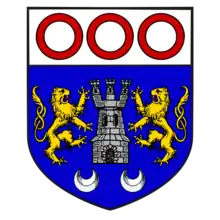O'Houlihan (dynasty)
The source of the name "hUallacháin" (Houlihan) is from the progenitor of the family Prince Uallachan Mac Flann:[1] "A rough-fettering lord of distinguished valour, venomous- weaponed, h-Uallachan."[2] An Irish warrior and Prince of Siol Anmchadha. His name means "Proud", or "Arrogant".[3]
| Houlihan Family Ó hUallacháin Houlahan, Mac Uallacháin, Hoolahan, Ua hUallacháin, Oulahan, Cuolahan, etc. | |
|---|---|
 Arms of O'Houlihan | |
| Parent family | Uí Mháine (Hy Many) |
| Country | |
| Current region | |
| Etymology | "Of Uallachán" |
| Founder | Uallachán |
| Historic seat | Siol Anmchadha Garrycastle |
| Titles | Lord of Muintir Cionaetha
Chief Ó hUallacháin family Chief of Siol Anmchadha (former) King of Siol Anmchadha (former) Prince of Siol Anmchadha (former) |
| Style(s) | The hUallacháin (Lit. "The Houlihan") |
| Connected families | Ua Madadhan (O'Madden), of Connaught
Hoolahan, Of Clan Colgan, King's County. Holahan, Of Kilkenny. |
The Houlihan family is a noble house and clan descending from Uí Mháine in County Clare. We can see this in the patronymic naming system: "Uallachan, son of Flann, son of Flannchadh, son of Innrachtach, son of Maelduin, son of Donngal, son of Anmchadh, son of Eoghan Buac."[1][4][5]
There is 3 different lines of Houlihan which come from different places. The name found in this article is the main line whom were "Chiefs of Siol Anmchadha in Hy-Maine" as listed in John O'Hart's Pedigree of the Irish Nation.[4]
In the 17th century, the O'Houlihans were pushed by the forces of Oliver Cromwell into Connachta where they became part of the Uí Fiachrach Aidhne which was the southern branch of the Uí Fiachrach.[6]
History
Notable persons of the name
Uallachan Mac Flann, Chief of the Name, Prince of Siol Anmchadha.
King Giolla Finn Mac Uallachain, Chief of the Name Ó hUallacháin, Chief of Siol Anmchadha, King of Siol Anmchadha (1096-1101)[9][5]
Archbishop of Cashel Donal Ua hUallacháin (1171-1182)[10]
See also
- Pre-Norman invasion Irish Celtic kinship groups, from whom many of the modern Irish surnames came from
References and citations
- "The Tribes and Customs of Hy-Many, commonly called O'Kelly's Country". celt.ucc.ie. Retrieved 2023-07-19.
- O'Donovan, John (1843). The Tribes and customs of Hy-Many, commonly called O'Kelly's country. Now first published form the Book of Lecan, a MS. in the Library of the Royal Irish Academy; with a translation and notes ... by John O'Donovan. Robarts - University of Toronto. Dublin : Irish Archaeological Society.
- "Hoolahan (No.3) family genealogy - Irish Pedigrees". www.libraryireland.com. Retrieved 2023-07-19.
- O'Hart, John (1892). Irish pedigrees; or, The origin and stem of the Irish nation. University of Pittsburgh Library System. Dublin, J. Duffy and Co.; New York, Benziger Brothers.
- "FamilyTreeDNA - Genetic Testing for Ancestry, Family History & Genealogy". www.familytreedna.com. Retrieved 2023-07-19.
- Cairney, C. Thomas (1989). Clans and Families of Ireland and Scotland. Jefferson, North Carolina, United States, and London: McFarland & Company. pp. 96–97. ISBN 0899503624.
- De Breffny, Brian (1982). Irish family names : arms, origins, and locations. Internet Archive. Dublin : Gill and Macmillan. ISBN 978-0-7171-1225-8.
- O'Laughlin, Michael C. (1997). The book of Irish families, great & small. Internet Archive. Irish Genealogical Foundation. ISBN 978-0-940134-15-7.
- O'Donovan, John (1849). Annals of the kingdom of Ireland. University of California Libraries. Dublin : s.n.
- MacLysaght, Edward (1985). Irish families : their names, arms, and origins. Internet Archive. Dublin : Irish Academic Press. pp. 105–106. ISBN 978-0-7165-2364-2.